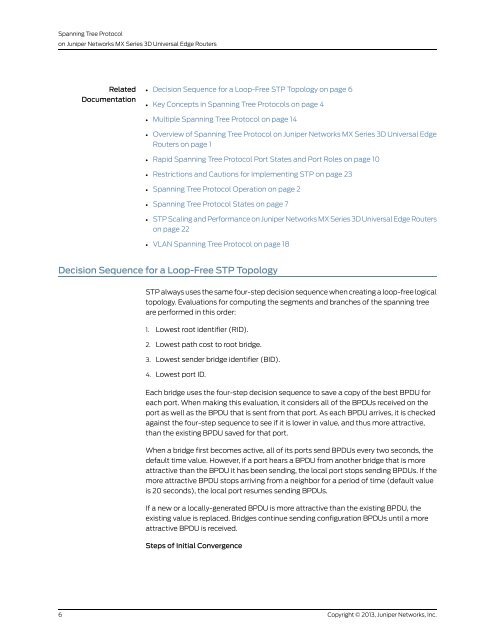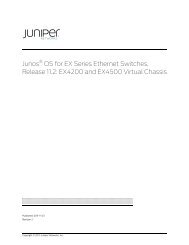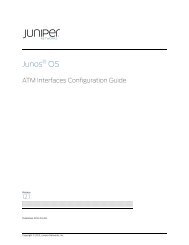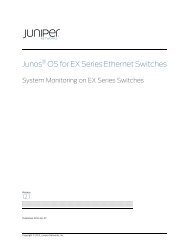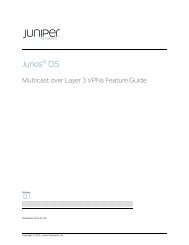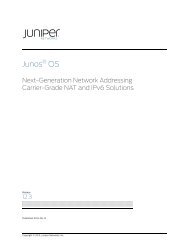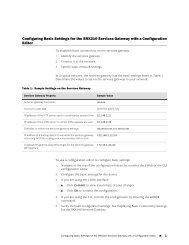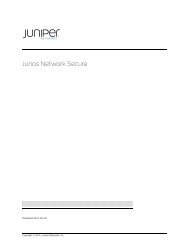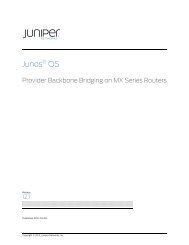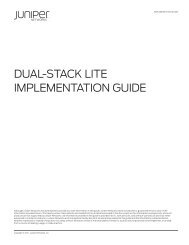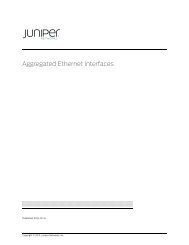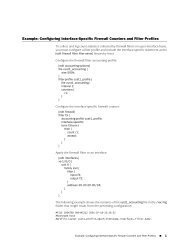Spanning Tree Protocol on Juniper Networks MX Series 3D ...
Spanning Tree Protocol on Juniper Networks MX Series 3D ...
Spanning Tree Protocol on Juniper Networks MX Series 3D ...
You also want an ePaper? Increase the reach of your titles
YUMPU automatically turns print PDFs into web optimized ePapers that Google loves.
<str<strong>on</strong>g>Spanning</str<strong>on</strong>g> <str<strong>on</strong>g>Tree</str<strong>on</strong>g> <str<strong>on</strong>g>Protocol</str<strong>on</strong>g><br />
<strong>on</strong> <strong>Juniper</strong> <strong>Networks</strong> <strong>MX</strong> <strong>Series</strong> <strong>3D</strong> Universal Edge Routers<br />
Related<br />
Documentati<strong>on</strong><br />
• Decisi<strong>on</strong> Sequence for a Loop-Free STP Topology <strong>on</strong> page 6<br />
• Key C<strong>on</strong>cepts in <str<strong>on</strong>g>Spanning</str<strong>on</strong>g> <str<strong>on</strong>g>Tree</str<strong>on</strong>g> <str<strong>on</strong>g>Protocol</str<strong>on</strong>g>s <strong>on</strong> page 4<br />
• Multiple <str<strong>on</strong>g>Spanning</str<strong>on</strong>g> <str<strong>on</strong>g>Tree</str<strong>on</strong>g> <str<strong>on</strong>g>Protocol</str<strong>on</strong>g> <strong>on</strong> page 14<br />
• Overview of <str<strong>on</strong>g>Spanning</str<strong>on</strong>g> <str<strong>on</strong>g>Tree</str<strong>on</strong>g> <str<strong>on</strong>g>Protocol</str<strong>on</strong>g> <strong>on</strong> <strong>Juniper</strong> <strong>Networks</strong> <strong>MX</strong> <strong>Series</strong> <strong>3D</strong> Universal Edge<br />
Routers <strong>on</strong> page 1<br />
• Rapid <str<strong>on</strong>g>Spanning</str<strong>on</strong>g> <str<strong>on</strong>g>Tree</str<strong>on</strong>g> <str<strong>on</strong>g>Protocol</str<strong>on</strong>g> Port States and Port Roles <strong>on</strong> page 10<br />
• Restricti<strong>on</strong>s and Cauti<strong>on</strong>s for Implementing STP <strong>on</strong> page 23<br />
• <str<strong>on</strong>g>Spanning</str<strong>on</strong>g> <str<strong>on</strong>g>Tree</str<strong>on</strong>g> <str<strong>on</strong>g>Protocol</str<strong>on</strong>g> Operati<strong>on</strong> <strong>on</strong> page 2<br />
• <str<strong>on</strong>g>Spanning</str<strong>on</strong>g> <str<strong>on</strong>g>Tree</str<strong>on</strong>g> <str<strong>on</strong>g>Protocol</str<strong>on</strong>g> States <strong>on</strong> page 7<br />
• STP Scaling and Performance <strong>on</strong> <strong>Juniper</strong> <strong>Networks</strong> <strong>MX</strong> <strong>Series</strong> <strong>3D</strong> Universal Edge Routers<br />
<strong>on</strong> page 22<br />
• VLAN <str<strong>on</strong>g>Spanning</str<strong>on</strong>g> <str<strong>on</strong>g>Tree</str<strong>on</strong>g> <str<strong>on</strong>g>Protocol</str<strong>on</strong>g> <strong>on</strong> page 18<br />
Decisi<strong>on</strong> Sequence for a Loop-Free STP Topology<br />
STP always uses the same four-step decisi<strong>on</strong> sequence when creating a loop-free logical<br />
topology. Evaluati<strong>on</strong>s for computing the segments and branches of the spanning tree<br />
are performed in this order:<br />
1. Lowest root identifier (RID).<br />
2. Lowest path cost to root bridge.<br />
3. Lowest sender bridge identifier (BID).<br />
4. Lowest port ID.<br />
Each bridge uses the four-step decisi<strong>on</strong> sequence to save a copy of the best BPDU for<br />
each port. When making this evaluati<strong>on</strong>, it c<strong>on</strong>siders all of the BPDUs received <strong>on</strong> the<br />
port as well as the BPDU that is sent from that port. As each BPDU arrives, it is checked<br />
against the four-step sequence to see if it is lower in value, and thus more attractive,<br />
than the existing BPDU saved for that port.<br />
When a bridge first becomes active, all of its ports send BPDUs every two sec<strong>on</strong>ds, the<br />
default time value. However, if a port hears a BPDU from another bridge that is more<br />
attractive than the BPDU it has been sending, the local port stops sending BPDUs. If the<br />
more attractive BPDU stops arriving from a neighbor for a period of time (default value<br />
is 20 sec<strong>on</strong>ds), the local port resumes sending BPDUs.<br />
If a new or a locally-generated BPDU is more attractive than the existing BPDU, the<br />
existing value is replaced. Bridges c<strong>on</strong>tinue sending c<strong>on</strong>figurati<strong>on</strong> BPDUs until a more<br />
attractive BPDU is received.<br />
Steps of Initial C<strong>on</strong>vergence<br />
6<br />
Copyright © 2013, <strong>Juniper</strong> <strong>Networks</strong>, Inc.


